8 Product bundling strategies to attract and retain your most valuable customers
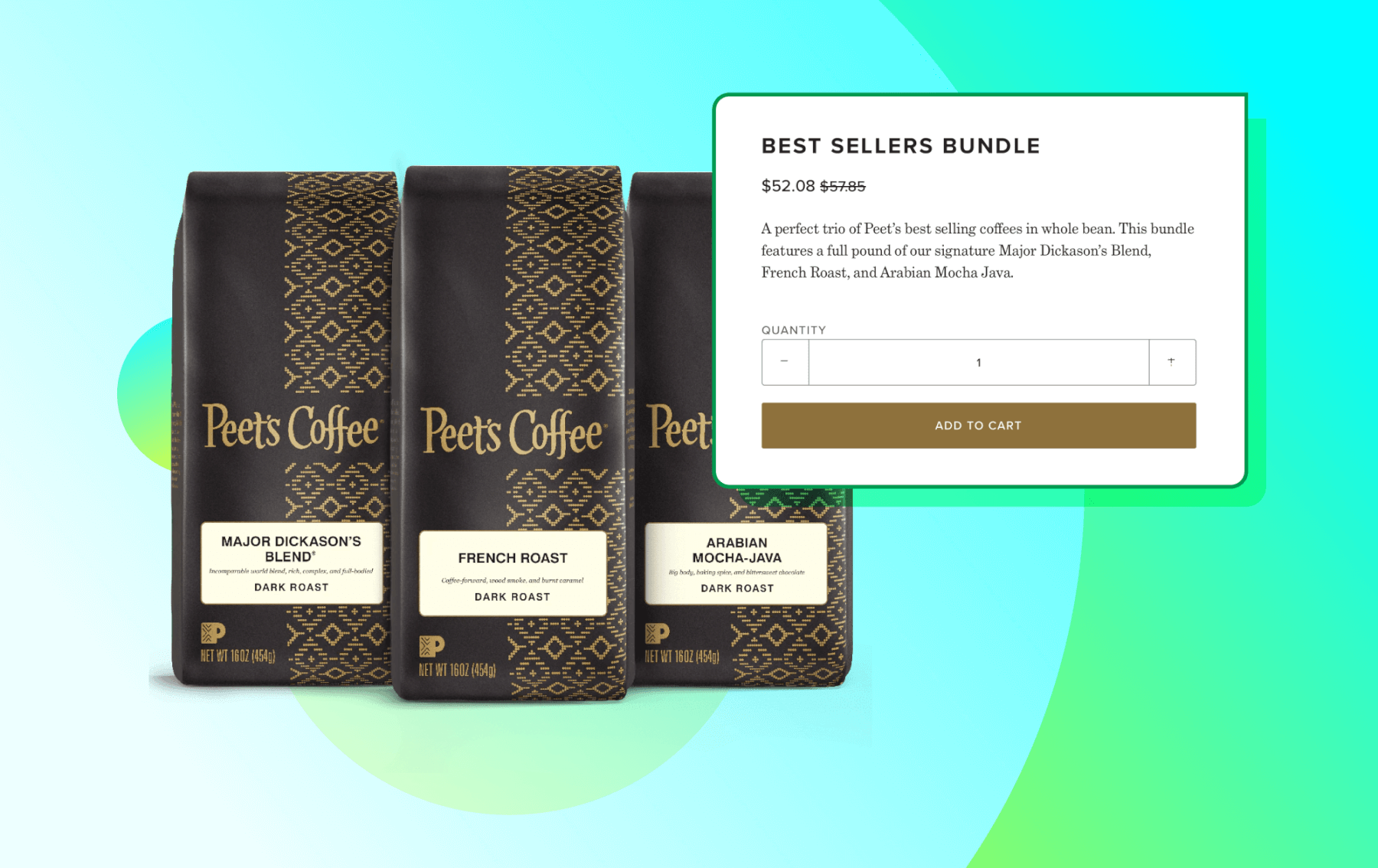
Selling one product is good. Moving extra inventory with each sale is even better.
And with recurring subscription orders? Well, it doesn’t get much better than that.
We can all agree that increasing average order value (AOV) is a cornerstone of sustainable growth for any eCommerce business. But with fierce competition and sky-high customer expectations to contend with, leading brands have to get creative with the tactics they use to stand out from the crowd and maximize their revenue streams — while still delivering as much value as possible to customers.
With the right strategy in place, product bundling can tick all of those boxes. Bundles can be used with or without a subscription experience to upsell higher tier products, or cross-sell additional items that are relevant to the initial purchase — and both of those paths lead to higher AOV.
Let’s just say there’s a reason why Amazon attributes 35% of its revenue to cross-selling — the experts at McKinsey say it can increase sales by 20% and profits by 30%.
Successful product bundling is both an art and a science, and there’s a lot to gain by getting it right. It all begins with finding the right product bundling strategy for your brand. On that front, this article is here to help. Let’s dive into the different types of product bundles, why they work, and how to make them work even harder for you — so you can set a new bar for AOV and revenue across subscriptions and one-time purchases, without breaking a sweat.
What is product bundling and why is it so beneficial?
Product bundling is a sales strategy where eCommerce brands sell multiple products as a single unit to encourage shoppers to buy more items and increase the overall value of their purchase.
And customers happen to love them. Whether they’re getting an entire haul at a lower price than if they’d bought each item separately, discovering new products curated just for them, or simply enjoying less friction and decision fatigue in the shopping experience, product bundles can help you become their preferred brand.
Brands and consumers can both win big with product bundles, but let’s take a look at some reasons why they’re especially beneficial to eCommerce businesses.
Higher perceived value
We’ve established that product bundles can work magic on your AOV — the reason behind that is they tend to increase the perceived value of your offering and appeal to cost conscious customers looking to get more bang for their buck.
Even if the bundle technically contains some upsells or cross-sells.
By nature, product bundles take the focus off of individual price points, which is particularly helpful if you want customers to buy another small item to maximize their purchase (think: a carrying case for makeup, or a charger for a phone).
Building the price of complimentary or add-on products into the main product’s price will make your product bundles seem like too good of an offer to refuse.
Better product discovery
Product bundles give customers a chance to discover — and fall in love with — a new product they wouldn’t have purchased on their own, regardless of whether they’re a brand new customer or they’re already happily enrolled in a replenishment subscription.
If a new customer adds an item to their cart, you can show them bundle options with upsells or cross-sells based on the original product. The more products they try, the more chances they have to become loyal to your brand — or even a subscriber some day.
And if a subscriber visits your site, you can offer a bundle with add-on products to complement the items in their next subscription order.
Perfect segue…
An elevated customer experience
Value and convenience are paramount for customers, and product bundles can deliver both. Instead of seeking out and researching individual items, shoppers can find pre-packaged options that address multiple needs in a single product bundle.
Removing that sort of friction not only speeds up the purchasing process, but leaves a good impression on customers who expect brands to do it all — or at very least, deliver savings and make their lives easier.
As far as what brands get in return for the stellar customer experience? Up to a 16% price premium on products and services, on top of increased loyalty.
Smooth inventory management and clearance
Product bundling is also an effective strategy for managing inventory and clearing out slow-moving or excess stock. By bundling less popular items with more popular ones, brands can quickly move inventory and reduce carrying costs.
At the end of the day, inventory management comes with costs no matter how well you forecast supply and demand. But moving more units with each order can put brands on the road to better efficiency with storage, order-picking, and warehouse staffing.
A golden opportunity for differentiation
Consumers are looking to spend less than usual, and their standards for who they’ll spend money with are going up.
73% of consumers expect brands to understand their unique needs and expectations, and strategic bundling is a way for brands to prove that they do — and make unique product combinations, better value, or a more personalized shopping experience their competitive edge.
Top product bundling strategies with real-world examples
Product bundling comes with many benefits — and because they can be sold as one-time purchases or as an ongoing subscription, there are plenty of ways brands can go about it.
The product bundling strategies below are just a jumping off point. The only limit is each brand’s imagination…
Subscription bundling strategies
Subscriptions and product bundles go hand-in-hand as proven methods for growing AOV and LTV — in fact, they tend to work even better together.
Here’s how top brands and retailers are making subscription bundles part of their core offering.
Fixed kit subscription bundles
Also known as subscription boxes, fixed kit subscription bundles seek to delight customers with novel items that satisfy their curiosity.
This type of bundle allows customers to subscribe to a group of evergreen products, pre-defined by merchants and listed under a single SKU — so they’re great for teams with limited operational or dev resources.
Popular across industries like food and beverage, personal care, and home goods, it’s safe to say this is a form of product bundling that can appeal to just about anyone.
For an example, look no further than Good Ranchers’ variety of fixed kit subscription bundles designed to deliver honest and quality food to people’s tables.
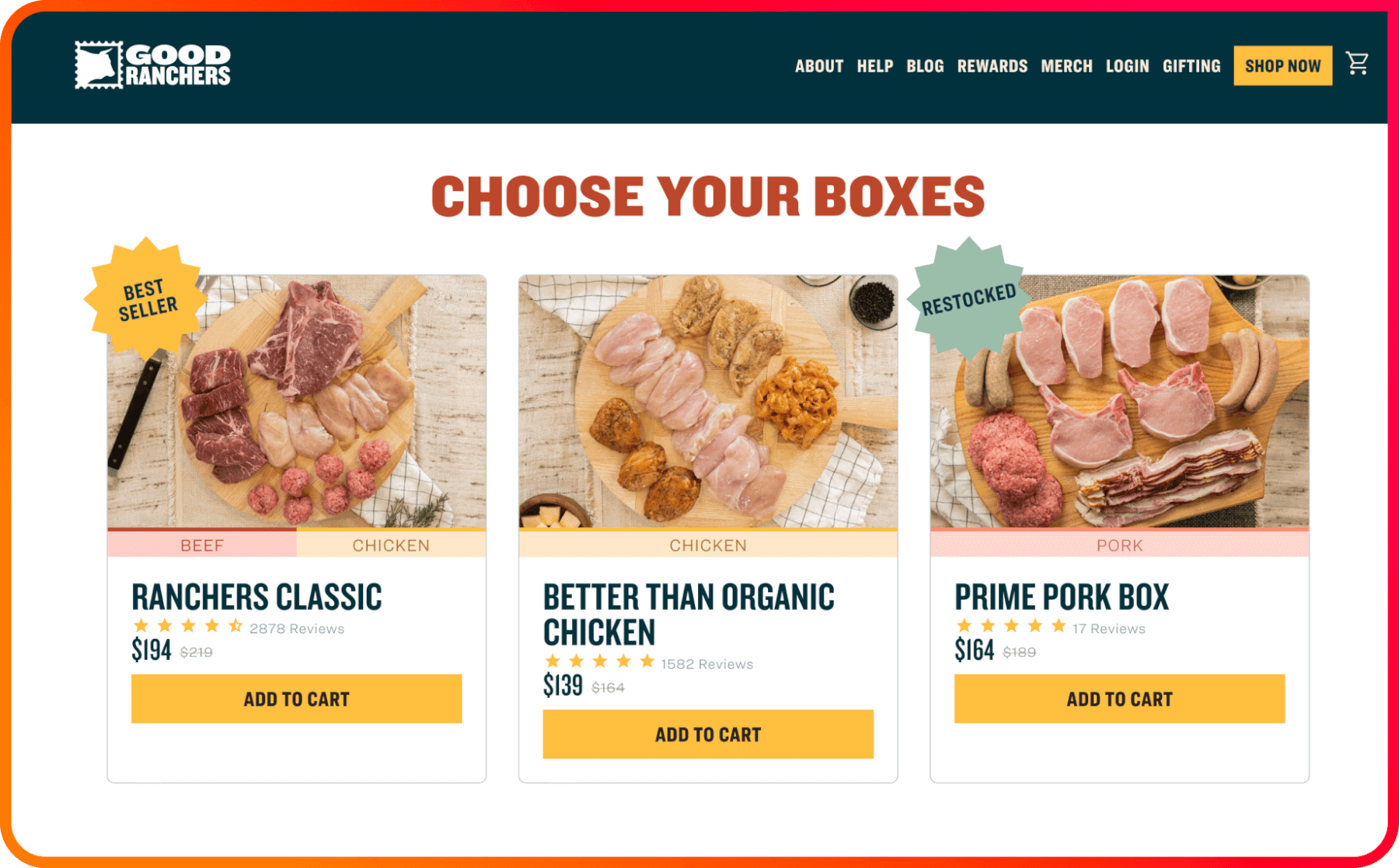
Customers can enroll in the subscription box that best fits their tastes and needs — and with boxes curated for the full gamut of dietary preferences and family sizes, Good Ranchers has found that customer satisfaction and enrollment have increased alongside their AOV.
Build your own subscription box
Unlike fixed kits, build your own subscription box let subscribers select their own personalized group of products to try each month in their subscription order.
This subscription box strategy gives subscribers the personalization they crave, making them less likely to churn due to overstock or product fatigue. For brands like KIND Snacks, that means a sustainable increase in AOV.
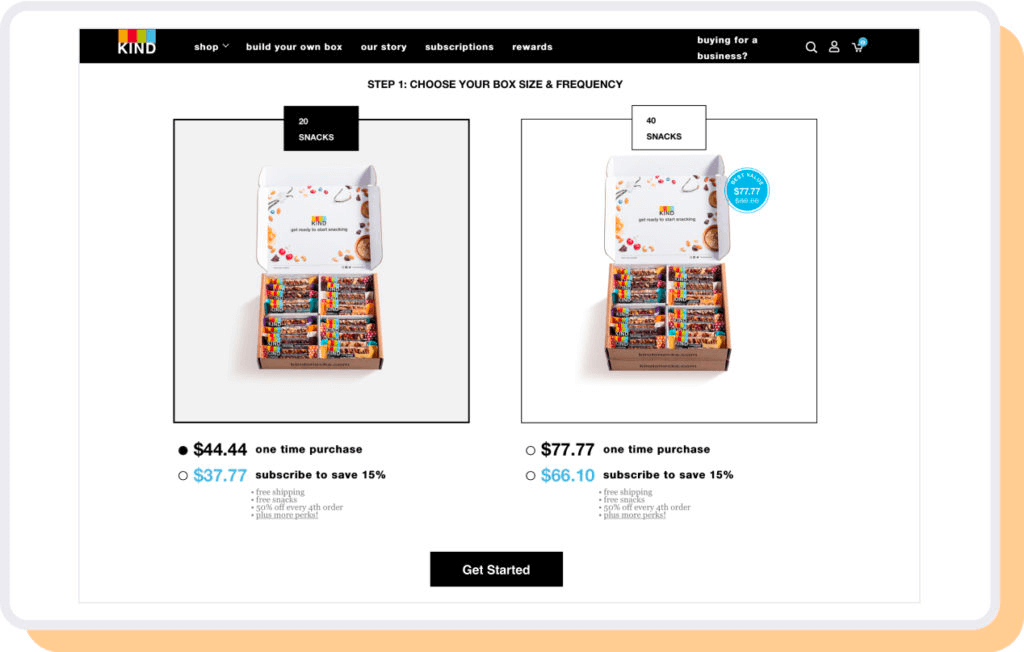
KIND used Ordergroove’s REST APIs to build a custom interface to power their popular Build Your Own Box experience. In return for delivering a bespoke subscriber experience, they’ve seen an impressive 24% increase in AOV.
Rotating club subscription bundles
Perhaps the most complex of the subscription bundle strategies, rotating clubs max out the novelty factor for subscribers by allowing them to choose from a new selection of rotating products each month.
Within rotating club subscription bundles, there are two subtypes:
Surprise & delight clubs
Surprise & delight clubs give subscribers a different group of products in each order, curated especially for a certain time of year. Popular in categories like groceries, gifts, wine, and apparel, surprise & delight clubs are known to provide a memorable subscriber experience — for brands, that pays off with stronger retention and better LTV as subscribers stick around to see what’s next.
Peet’s Coffee uses a subscribe & delight club bundling strategy to keep subscribers hooked, no matter their coffee preferences. To satisfy the less adventurous types — and move more evergreen SKUs — they offer a rotating curation of their classic coffee products. And for the adventurous subscribers, Peet’s offers a subscribe & delight club bundle that delivers new varieties each spring, summer, fall, and winter.
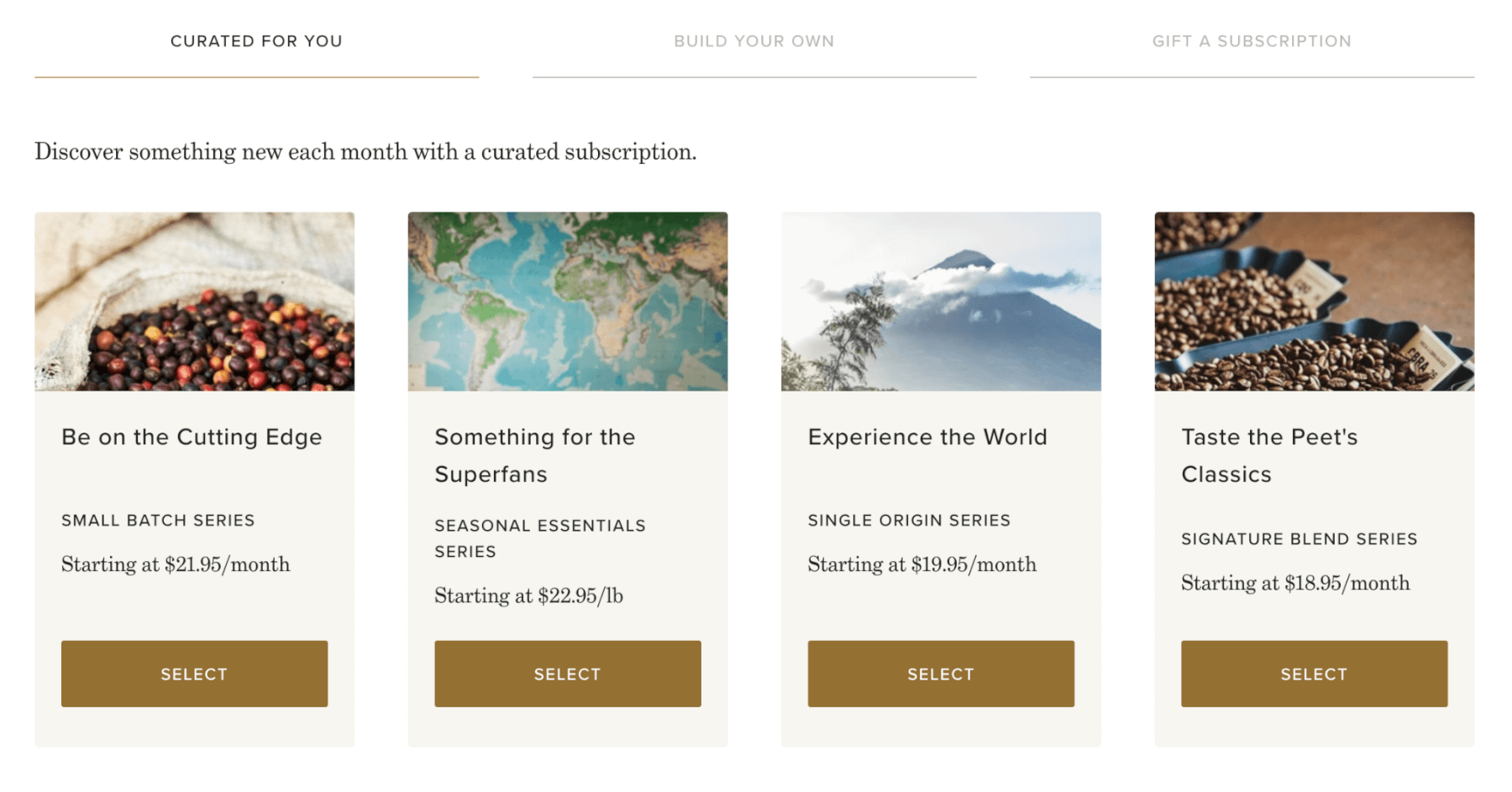
With such a robust subscribe & delight club offering, it may or may not be surprising that these subscription bundles helped Peet’s Coffee drive a 27% increase in subscribers in their first year with Ordergroove.
Planned clubs
Planned clubs are another option for brands looking to try out rotating club subscription bundles. This variation gives subscribers a curated group of products each month, designed to reach them in a specific order regardless of when they initially signed up.
Most commonly seen in categories like baby toys, books, and accessories, this type of subscription bundle is known to boost LTV because, by their very nature, they appeal to people who expect to stay enrolled in the subscription for a longer period of time.
And because they entail such phased product curation, merchants can plan their marketing campaigns and inventory needs far in advance so subscribers can progress through their orders smoothly.
For example, Lovevery uses planned clubs to send parents bundles of toys for each developmental stage of their baby every two months. They can determine how much inventory they need for each developmental stage — and precisely when they’ll need it — based on when subscribers enroll.
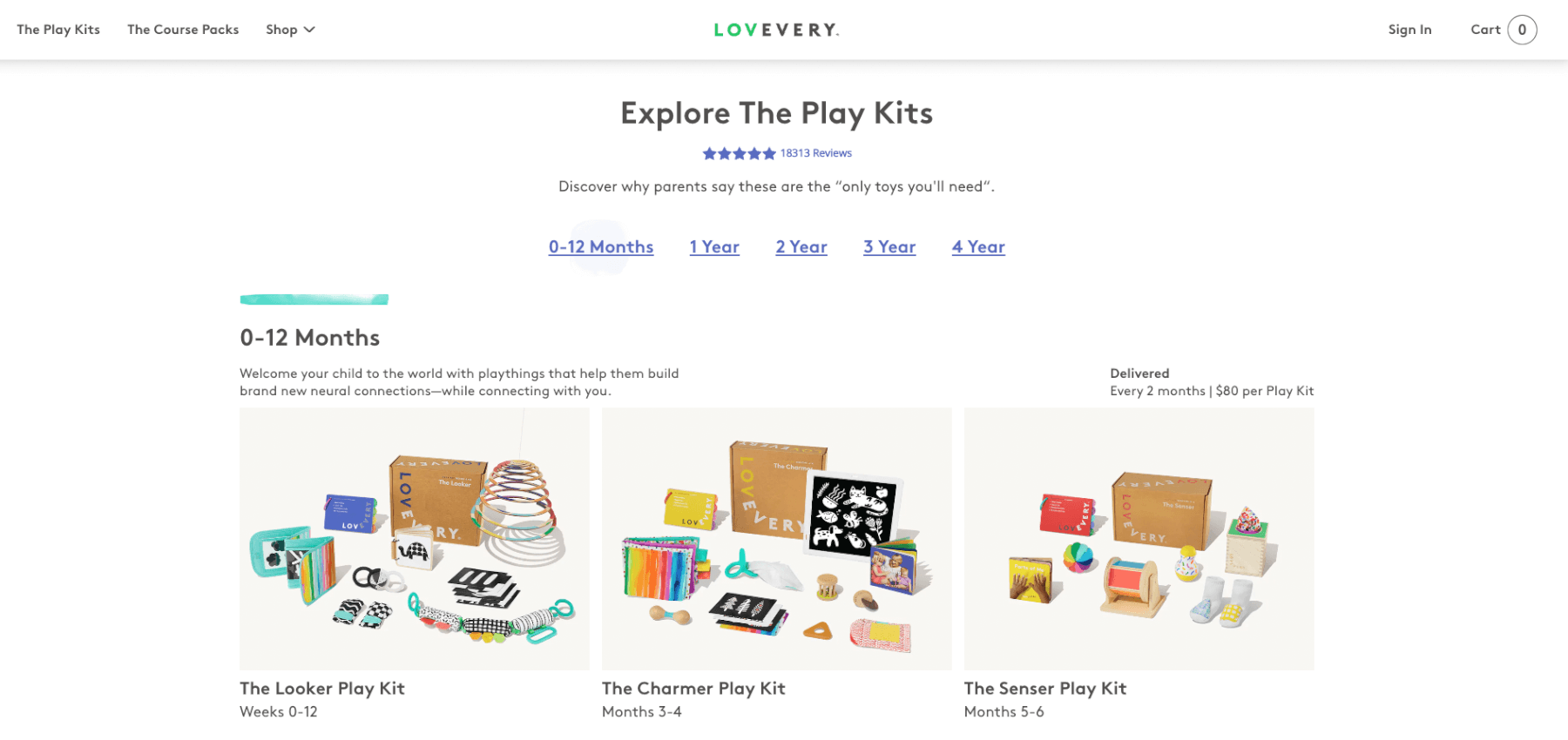
Product bundling strategies for one-time purchases
Brands can use one-time purchase product bundles as a standalone solution for growing their AOV, but they can also be used alongside a subscription bundle strategy to capture a wider net.
Whether they’re on their own or part of the subscription ecosystem, here are the most common ways brands are choosing to offer product bundles as a one-time purchase.
Pure bundling
Pure bundling is when brands create an exclusive offer by selling certain products only as a bundle, rather than letting customers purchase them separately. The idea is to create urgency and fear of missing out, so customers act fast to get their hands on rare products — think: Glossier’s holiday gift sets, featuring limited edition shades and product sizes.
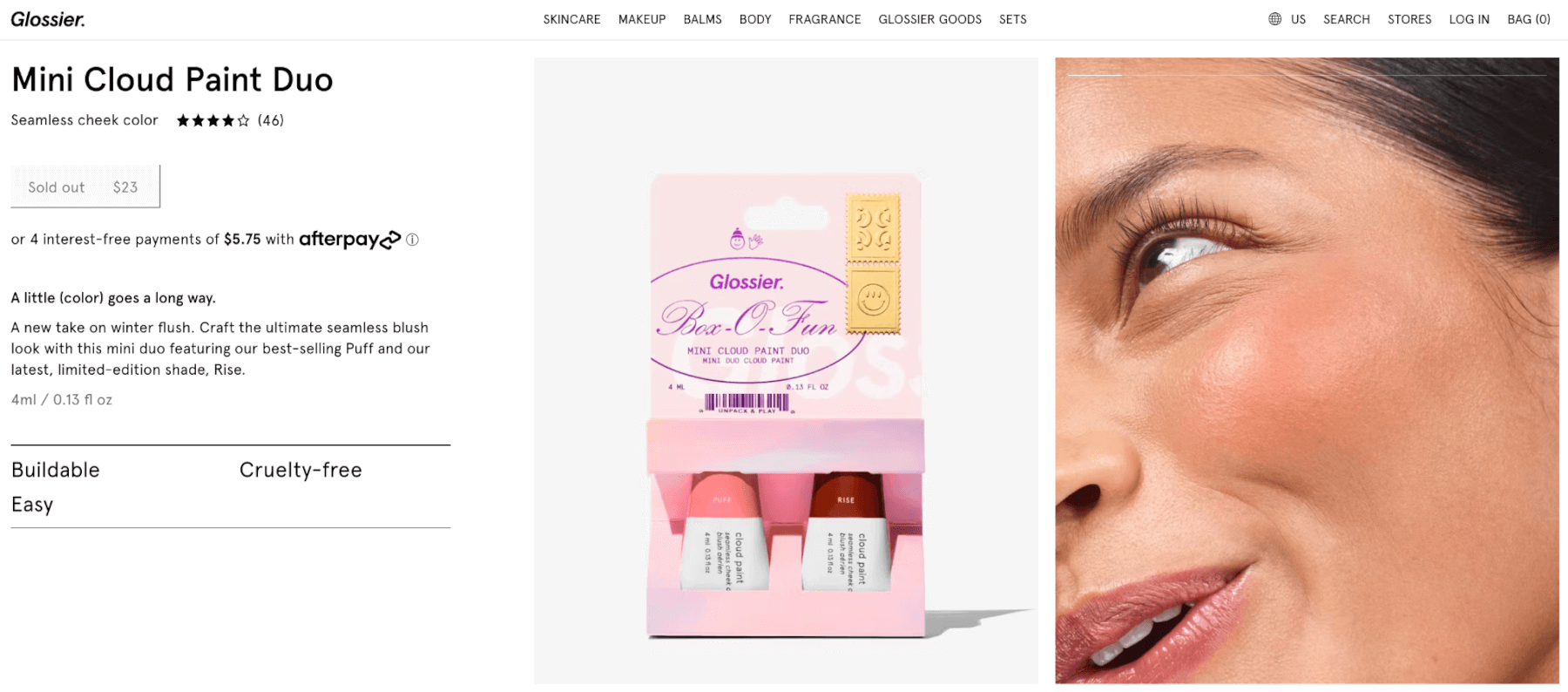
Mixed bundling
Unlike pure bundling, mixed bundling is a more flexible approach where brands make products available individually or as part of a bundle, so customers can choose whichever option best meets their needs. This approach tends to work best with complementary products that are often used together, enhancing the overall value proposition of the offer.
For example, Dollar Shave Club sells razor components and shaving cream on their own as a one-time purchase or as a subscription — but they also offer a mixed bundle starter set, so customers can get everything they need for a smooth shave in a single purchase.
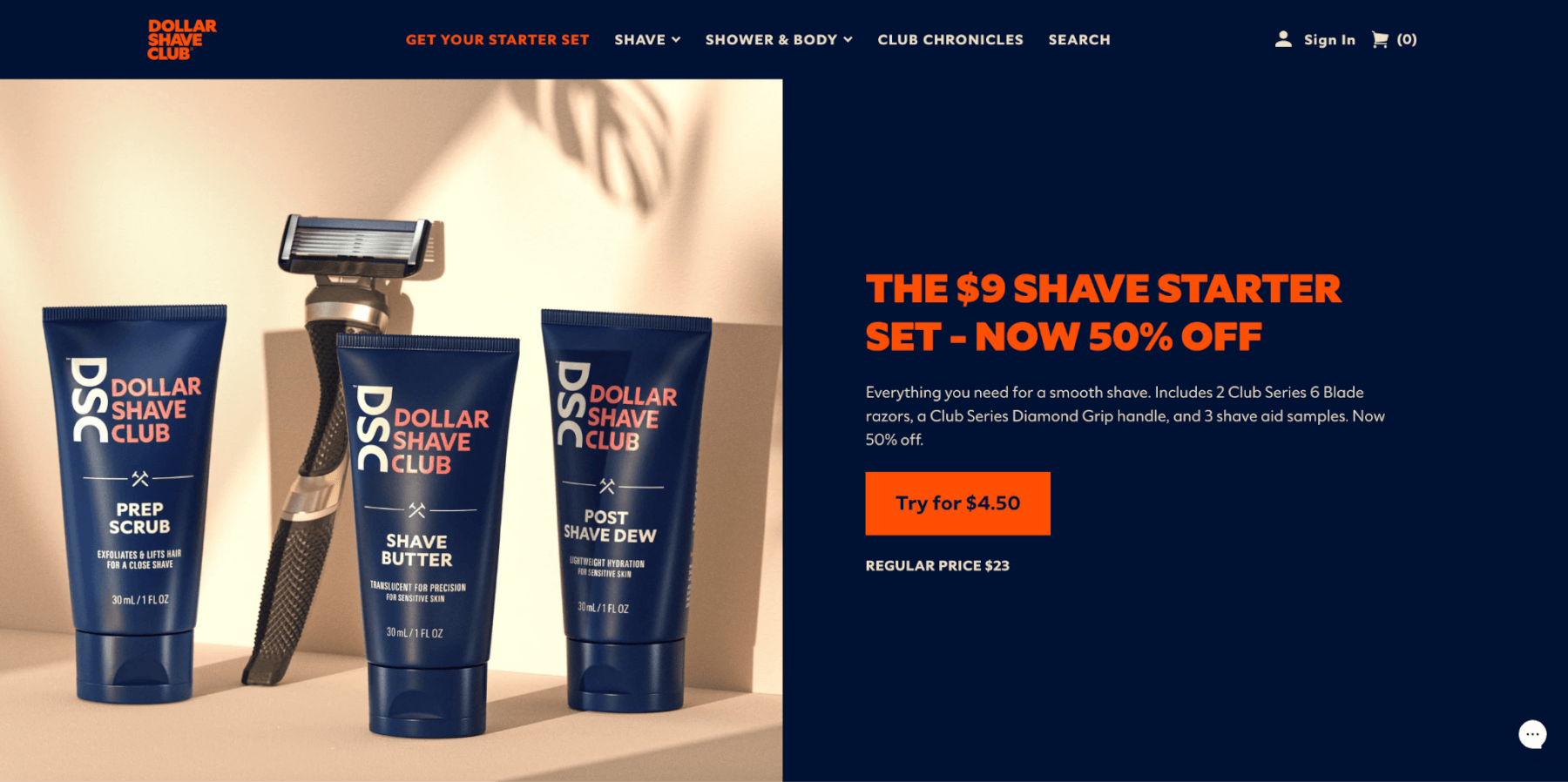
Cross-sell bundling
Cross-sell bundling is when brands pair a popular or high-margin product with a less popular one. This encourages customers to discover and purchase items they may not have considered otherwise.
Yankee Candle’s ready-made bundles of candles and accessories are an example of how this can look in practice. Their wick-trimmers and candle holders may not be as beloved as the candles themselves, but Yankee Candle can sell more of them overall by bundling them with their most popular candles.
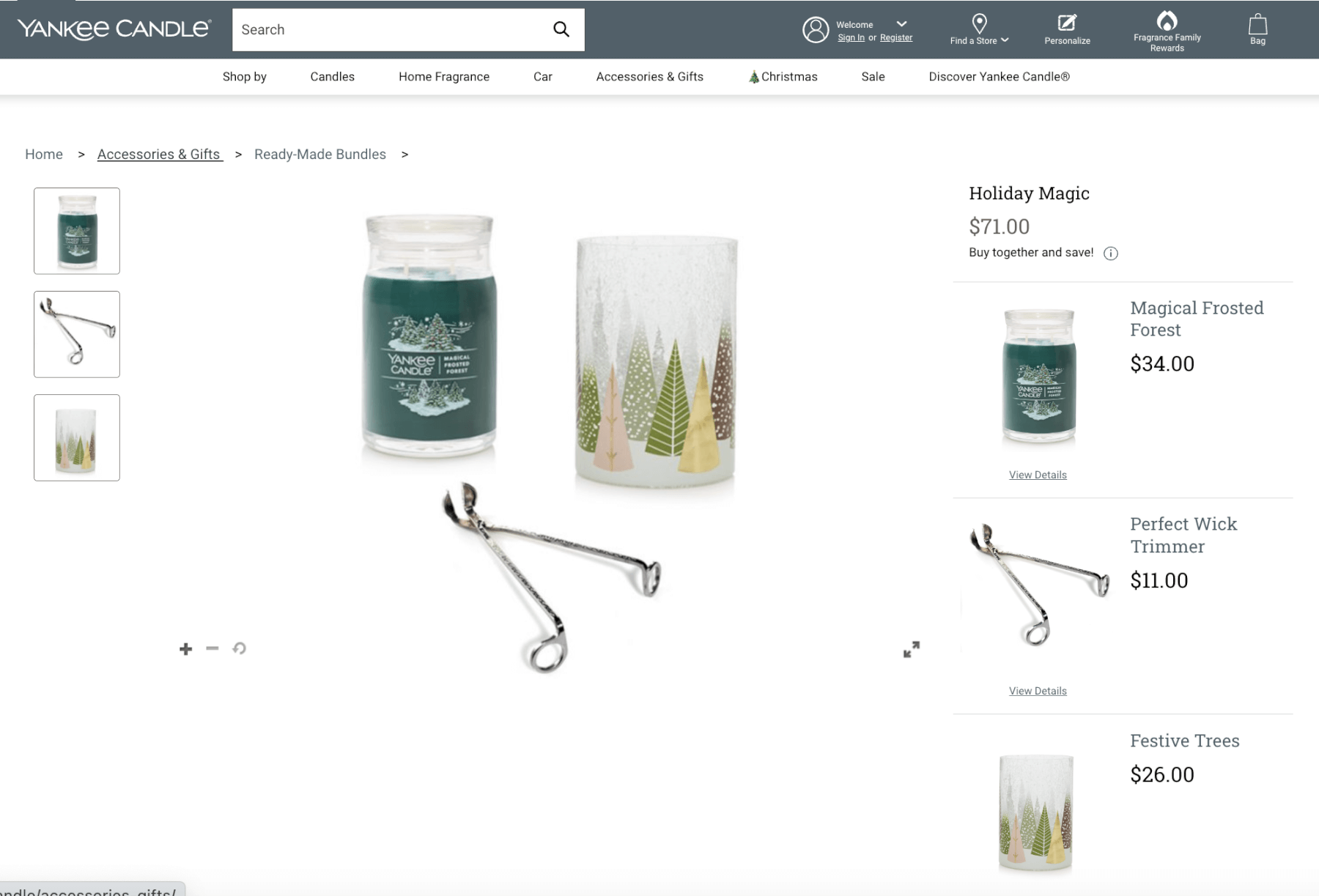
Price bundling
Price bundling can take many forms, but it always involves giving some extra value back to the customer. Think: discounts or free gifts with purchase for buying multiple items.
Some brands will curate a set of items that must be purchased together to unlock a discount. Others automatically offer customers a bundle discount when they buy multiple items. And some include a free gift when customers purchase a certain number of items.
No matter which price bundling approach a brand chooses, customers feel they scored a good deal — even if they spend more to get there. Take Tula Skincare for an example of how price bundles can look in action.
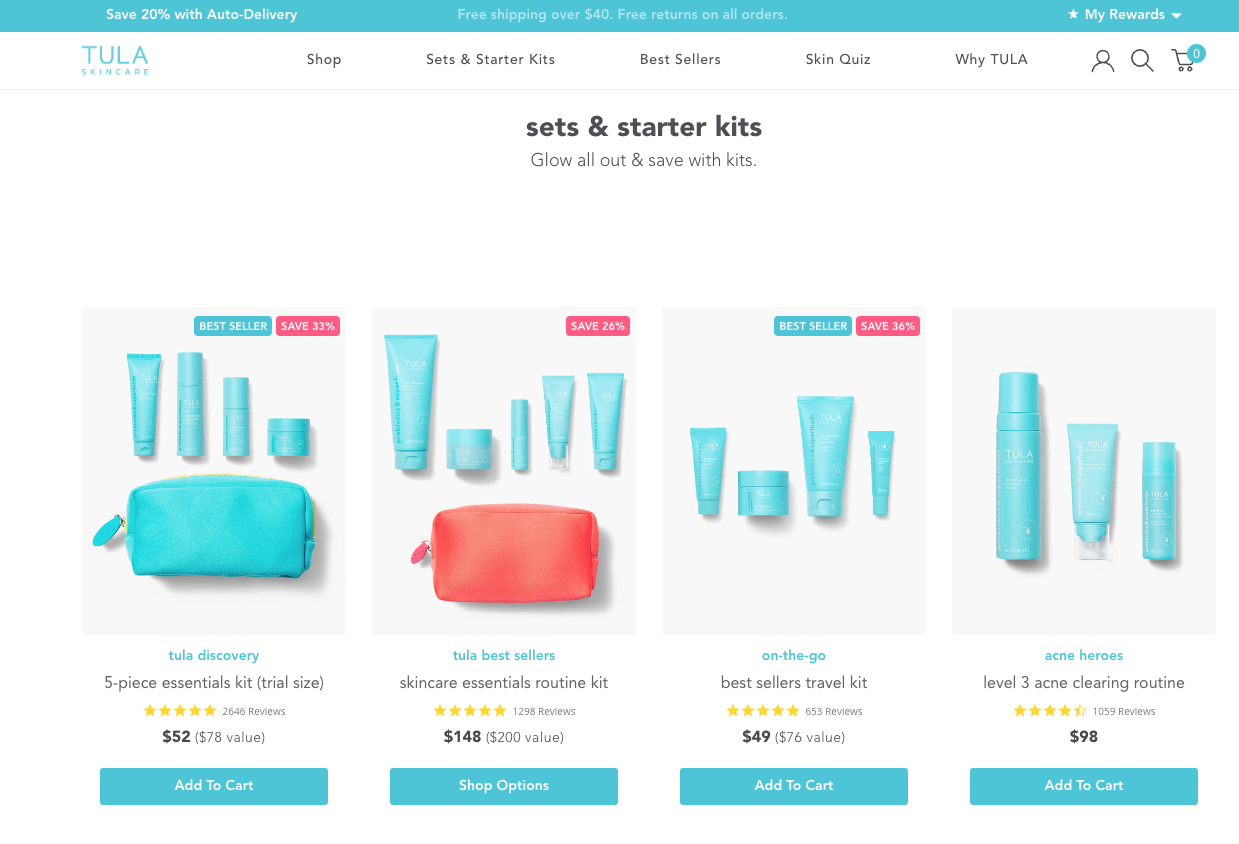
Across their impressive range of sets and starter kit bundles, Tula Skincare highlights the bundle savings as both a percent off and a dollar amount to make sure the value of the deal is crystal clear to potential customers.
Build your own bundles as a one-time purchase
Finally, many brands are seeing success with the most flexible and personalized option of all: A build your own bundle experience that lets customers curate their own set of products for a one-time purchase.
With this option, brands might have to compromise on total control over moving specific inventory or creating awareness about certain products — but they make up for it with stronger conversions among customers seeking out personalization at a friendly price point.
Native Remedies gives their customers a dynamic build your own bundle experience by making certain products eligible for an offer to buy two items, and get a third item free.
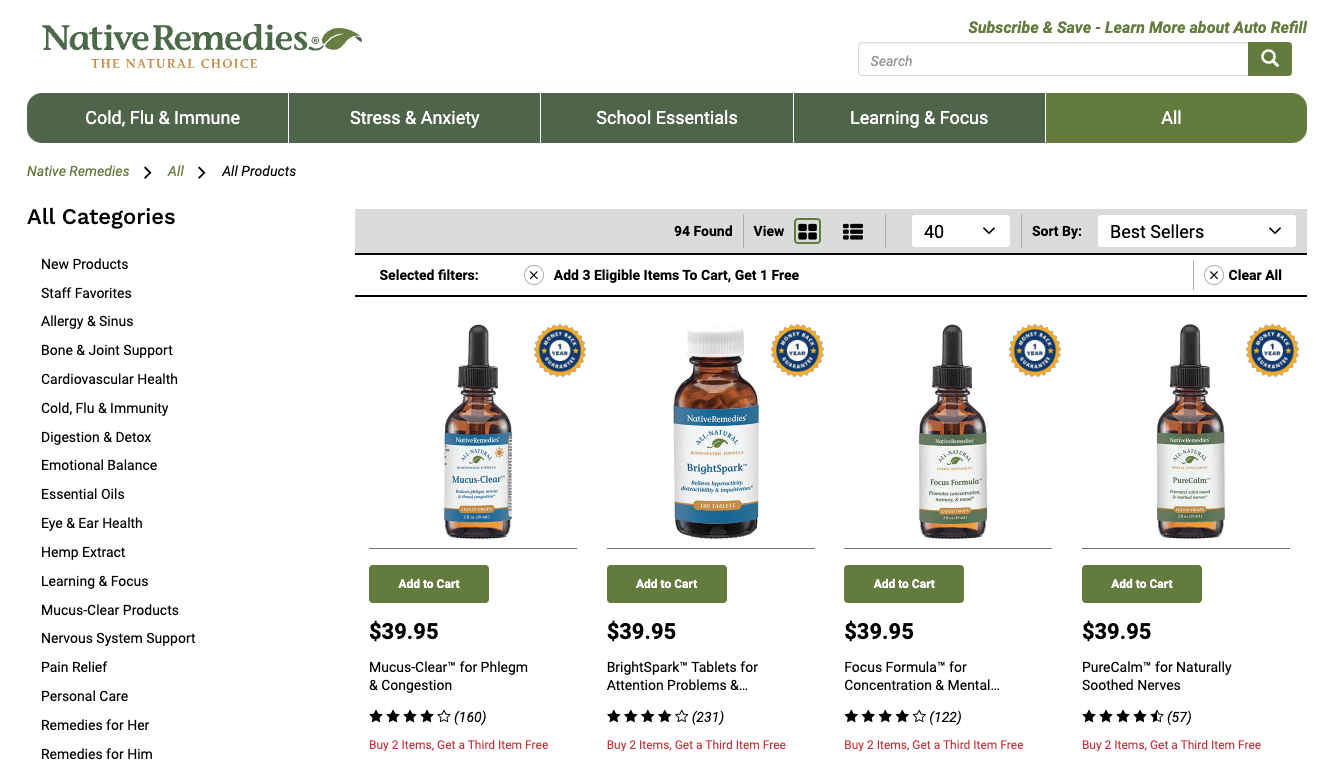
With this bundle offer applied to all 23 of their product categories, customers can mix and match remedies to create a custom bundle that’s perfect for them.
Best practices and tips for product bundling success
At the end of the day, a successful product bundling strategy requires a deep understanding of the customer, detailed planning, and stellar execution.
But if that sounds like a tall order, you can rest assured that you’ll get as much out of your product bundling strategy as you put into it. Here are a few more considerations to make sure your product bundles take off like a rocketship.
Anchor your strategy in customer data
No need to offer bundles based on intuition alone. As you craft your product bundling strategy, make analytics your new best friend.
Looking at areas like order history, purchase behavior, and inventory performance can help you identify products that work best together, how seasonality affects sales in different categories, and which items are frequently left behind in abandoned carts.
From there, you can craft strategic bundles to make the most of — or minimize the effects — of seasonality and customer behavior. And if you really want to go the extra mile, A/B testing different product combinations can help you pinpoint exactly which offers your customers prefer.
Focus your product bundling efforts
In the interest of honing the right promotion and pricing strategy for your bundles, it’s best to try one or two bundling techniques at a time. Even with the most granular data at your fingertips, it can be tough to predict exactly how bundles will be received — and the impact of most approaches comes down to the exact products in the bundle.
There are many balances to strike with your bundling strategy. Offering a discount while maintaining profitability. Communicating the value of the bundle without it feeling like a pushy sales tactic. And promoting product discovery for only the most relevant products.
Trying too many tactics at once can make it hard to spot the cause of whatever’s working — or not. out what’s working and what’s not.
To make sure you strike the right balance between attractive discounts and maintaining profitability — and communicating the value of your bundles as communicating value to customers without
Avoid the presenter’s paradox
Recall that bundles work best when they enhance the perceived value of your offering — that’s why you want to avoid the presenter’s paradox, which says bundling items that are obviously cheap with items that are more expensive will lower the perceived value of the offer. Even with an enticing discount.
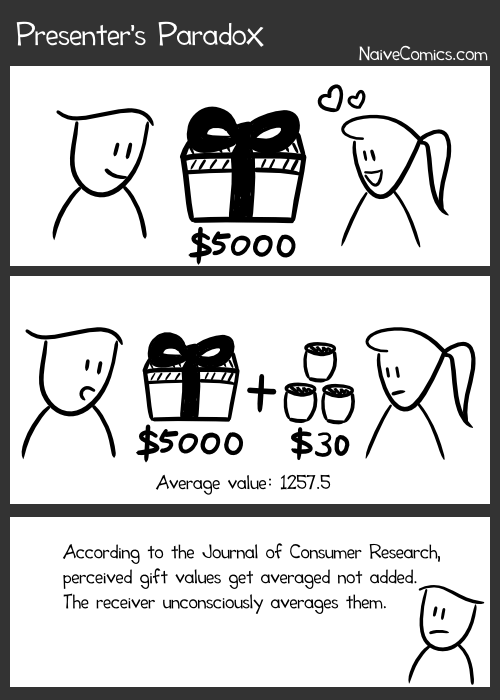
Psychology says that consumers unconsciously average the value of a bundle by the number of products instead — not the sum value of the products. So it’s best to bundle together items that are perceived as equal value, even if they’re not all that similar in price.
Get more out of every single subscription order
More perceived value. More customer loyalty.
Higher AOV on each order. Higher customer lifetime value — and ROI on all of your marketing.
Lower subscription product overstock. Lower subscriber churn.
With the breadth of upsides for brands and customers alike, it’s safe to say that testing out a product bundling strategy is low risk and high reward — especially if you offer subscriptions.
Crafting the right subscription bundling strategy for your brand is easy when you have flexible incentives, upsell capabilities, and subscriber analytics at your fingertips. Join the leading brands using Ordergroove to fuel their recurring subscription revenue with product bundles.